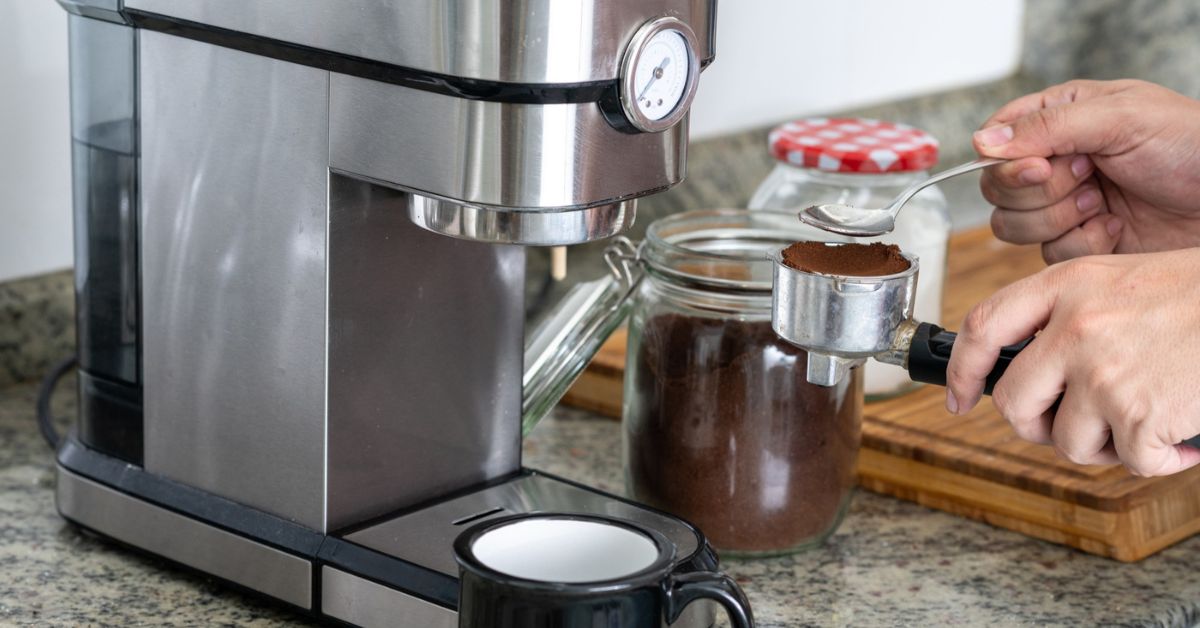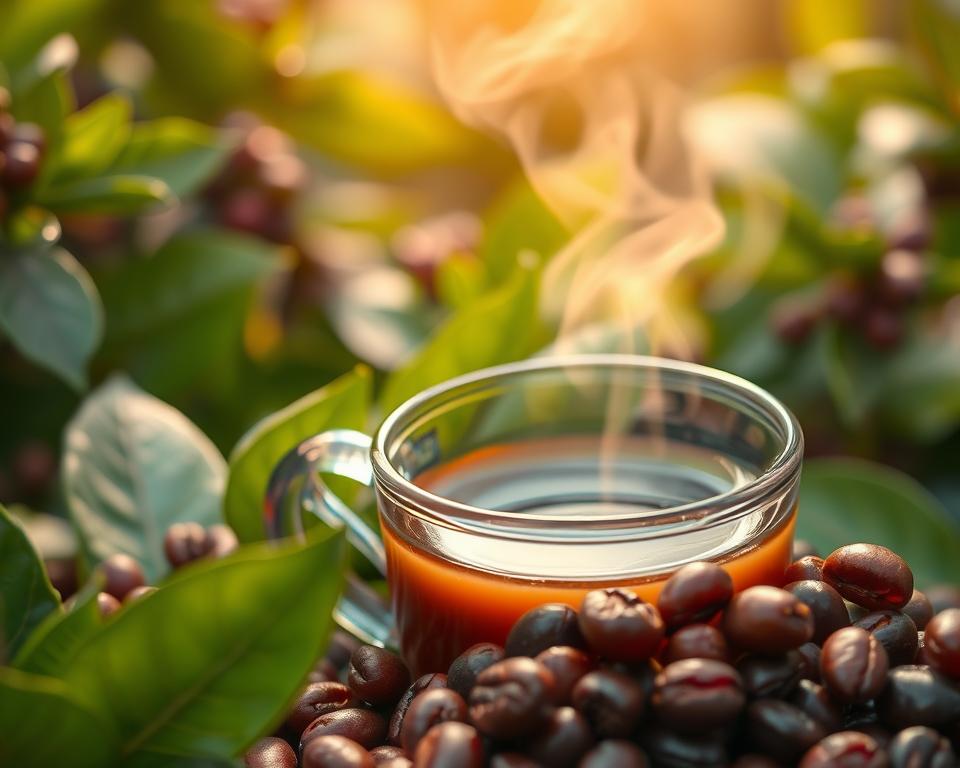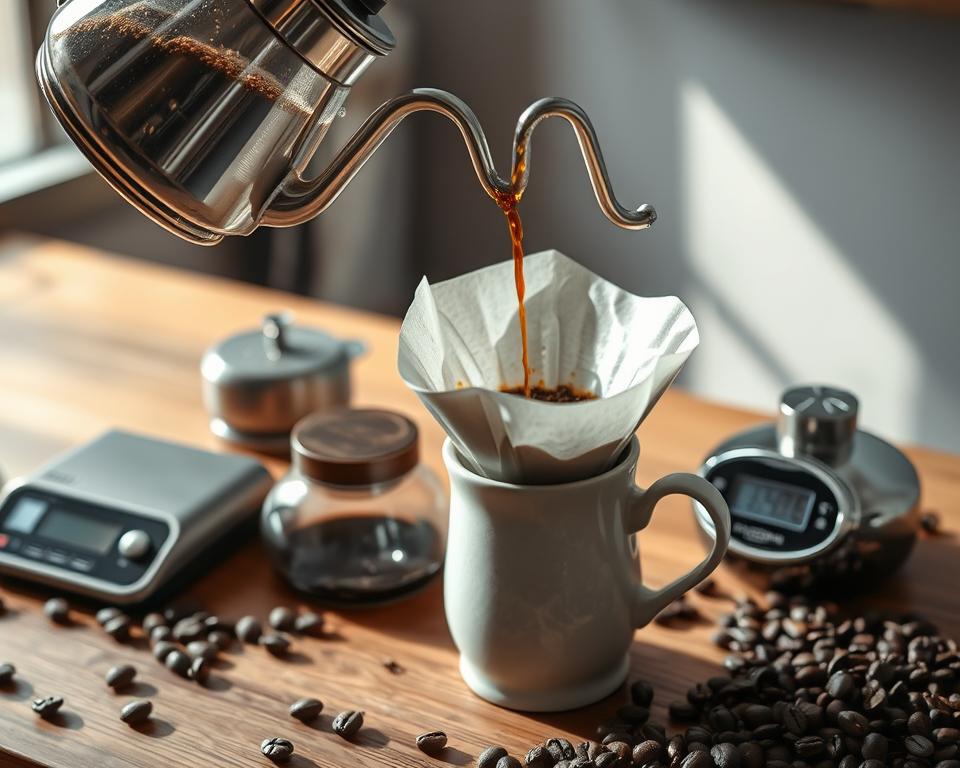I love high-quality, fresh coffee beans. For me, manual coffee brewing is the best. It lets me enjoy a cup or two that’s fresh and tasty. Using simple methods might seem hard at first. But, it gives you amazing control over how your coffee turns out.
Methods like pour-over and French Press make coffee making an art. They focus on the little things. I can make great coffee for just me or when I have friends over. These easy methods create delicious coffee. Let’s explore the beauty of making coffee this simple way. It makes our coffee breaks special.
The Charm of Low-Tech Coffee Brewing
Low-tech coffee brewing methods have a simple charm. They let you get up close with making coffee. From grinding beans to pouring hot water, you’re in charge. This turns a daily habit into an art form, filled with tradition.
The Appeal of Simplicity
Many love the simplicity of low-tech brewing. About half of coffee fans stick to the Drip method for its clean taste. It’s easy and doesn’t need fancy equipment. For example, 30% enjoy French Press for its rich flavor, done with just a press.

Also, 40% like to try new methods like hand-pour for unique tastes. Being able to control the brewing process is a big plus. This is why so many prefer manual methods, adding to the handcrafted coffee experience.
Connecting with Your Brew
Brewing coffee by hand creates a special bond. You notice the different flavors that each method brings out. In Japan, Vacuum Coffee offers clean tastes, showing the care in various methods. This highlights the cultural importance of coffee traditions.
Brewing coffee isn’t just about ease; it’s the quest for the best cup. Grinding beans when needed keeps the flavor strong, a common choice among enthusiasts. Using filtered water and the right temperatures is key, as most home brewers do. This avoids spoiling the taste.
Low-tech brewing means being involved with every step of making coffee. It turns a regular task into something meaningful. The personal effort and details heighten the coffee experience. This is what makes low-tech brewing so appealing.
Popular Low-Tech Coffee Brewing Methods
Low-tech coffee brewing methods are popular for their simplicity and great taste. They include the French Press, Pour-Over, and AeroPress. Each method brings out rich flavors in the coffee.
French Press
The French press technique is easy to use and makes coffee that’s rich and full-bodied. You steep coarsely ground coffee in hot water for 4 to 5 minutes. Then, press the plunger down gently.
This technique suits medium to dark roast blends best. It highlights the coffee’s body and texture. Coffee lovers who enjoy a strong cup often prefer it.
Pour-Over
Pour-over coffee is loved for showcasing complex flavors. You pour hot water over coffee grounds slowly and in a circle. This control over brewing time and temperature is key.
It might take some time to master, but the effort pays off. This method is great for light to medium roast single-origin beans. It especially brings out the coffee’s acidity and flavor subtleties.
AeroPress

The AeroPress is versatile, perfect for different recipes. It can make espresso-like coffee or smoother Americano styles. The brewing is quick, taking about 60 seconds with hot water.
It’s best for brewing one cup at a time using medium roast single-origin beans. The AeroPress adapts to many techniques, like the zero-bypass for a clean taste.
In short, whether you’re into the French press, pour-over coffee, or AeroPress recipes, these methods show low-tech is high-quality. You can enjoy a perfect cup of coffee that suits your taste.
Advantages of Low-Tech Coffee Brewing Methods
Low-tech coffee brewing methods are gaining fans, especially among those who love a hands-on approach. One key benefit is the rich flavor you get from fresh coffee beans. This method lets you interact more with your coffee. It offers a unique experience that you don’t get with mass-produced coffee.
Rich Flavor Extraction
Methods like the French Press and AeroPress are great for deep flavor. The French Press works well for medium to dark roast, making 2-3 cups in minutes. It lets the coffee grounds soak in hot water. This brings out a rich, full flavor. The AeroPress is great for medium roasts and gives you precise control over the taste. Both require little equipment but offer great taste.
Control Over Brewing Process
Manual brewing gives you control over the coffee-making process. This is perfect for those wanting a personal touch in their coffee. With pour-over methods, like Chemex or Hario v60, you can adjust many things. You can change the water temperature, pour rate, and time the coffee blooms. This affects the final cup’s taste, letting you make coffee just how you like it.
Manual brewing is not only about control but also about ease of cleaning. Using an AeroPress or a Moka pot means each brew is special. It’s not just about making coffee; it’s about enjoying the process. Also, taking time to savor each step makes the coffee ritual better.
How to Choose the Right Gear for Low-Tech Brewing
When picking out coffee gear for low-tech brewing, size is key. If you’re making coffee just for one, a smaller manual brewer like the Hario V-60 Coffee Dripper (Size 02) is ideal. It has a cone-bottom design that needs careful pouring, perfect for those who love control. But for making coffee in larger amounts, the Kalita Wave 185 Dripper works well. It has a flat bottom and special wavy filters that help make your coffee taste great every time.
Choosing the right material is also very important. You might want ceramic, glass, or stainless steel, and each has its benefits. Ceramic keeps your brew warm, while glass lets you watch the coffee as it brews, adding something special to your morning. Stainless steel is tough and looks cool and modern.
The design of your brewing gear can make a big difference in how easy it is to use. For example, manual brewing equipment like the flat-bottom dripper of the Kalita Wave 185 makes brewing straightforward. Your choice of filters, white or brown paper, can influence your coffee’s taste, with some reducing unwanted flavors.
How easy gear is to use is really important, too. Some brewing gear is great for beginners, while other types allow for more detailed control. Choosing your gear also means thinking about the coffee-to-water ratio. Using 1 gram of coffee for every 17 grams of water heated to 206 °F with a gooseneck kettle can get you awesome coffee.
Thinking about where to buy your gear is another thing to consider. Most unique coffee brewing essentials, like the filters for the Kalita Wave 185, are available online but might be hard to find in stores. It’s also good to think about using gear that’s good for the planet. Choosing products that are made in a responsible way can help the environment and support better coffee farming practices.
Last but not least, don’t forget about the social side of brewing coffee at home. Talking with other coffee enthusiasts and sharing tips can really improve your brewing skills. Whether you care most about easy use, the quality of materials, or being eco-friendly, the right manual brewing gear can make your coffee taste amazing.
Step-by-Step Guide to Mastering Pour-Over Coffee
If you’re starting out or already know your way around a coffee bar, this guide is for you. It covers everything needed to become a pour-over coffee pro. We’ll go through the gear, how to brew, and fix common mistakes.
Essential Equipment
To start, get the tools you’ll need. Here’s what’s important for top-notch pour-over coffee:
- A dripper (like the Kalita Wave or Hario V-60)
- Proper filters
- A gooseneck kettle for controlled pouring
- Freshly roasted beans (ideally within the past two weeks)
- A precise scale and grinder
Brewing Techniques
Got your equipment? Great! Here’s how to brew an amazing pour-over:
- Heat water to 195°F-205°F to get the taste right.
- Grind coffee to a medium-fine texture for your dripper.
- Rinse the filter with hot water to remove any paper flavor and heat the dripper.
- Put coffee in the dripper. Use 1 to 2 tablespoons per 6 ounces of water.
- Pour water slowly in circles, making sure to soak all the coffee evenly.
- Keep an eye on your pouring speed to avoid spilling over.
For the best pour-over, focus on consistency and finding the right balance. Play around with the grind, brew time, and water temperature to make it your own. Check out these perfect pour-over tips for more ideas.
Troubleshooting Common Issues
Sometimes, things don’t go as planned. Here are fixes for typical brewing troubles:
- Uneven extraction: Pour evenly and keep your coffee-to-water ratio consistent.
- Overflow: Pour too fast and it overflows. Slow down and watch the flow.
- Flat taste: Use filtered water. The type of water can change the taste a lot.
Follow these steps and tips to brew great pour-over coffee every time. It’s all about practice and tweaking your method.
Explore the Best Picks for Pour-Over Coffee
When picking the best coffee equipment for pour-over, several options stand out. The Kalita Wave 185 Dripper, Hario V60 Plastic Dripper, and Fellow Aiden drip coffee maker are top choices. They are known for their superior performance.
The Kalita Wave 185 Dripper is known for its even extraction. It’s great for beginners. Its design ensures all coffee grounds are evenly wet, giving a rich and balanced cup. That’s why it’s often called one of the best coffee equipment by both newbies and seasoned drinkers.
The Hario V60 Plastic Dripper is another great choice. It delivers gourmet-flavored coffee consistently. It’s great for highlighting the coffee’s acidity and unique flavors. However, it requires learning the right technique, making it perfect for enthusiasts of the brewing process. With its sleek design and effectiveness, the Hario V60 stands out among the top pour-over drippers.
The Fellow Aiden drip coffee maker is perfect for those who love automatic brewing. This device lets you customize brew strength and water temperature. It adds modern convenience to the pour-over method. It ensures high-quality without giving up simplicity. Thus, the Fellow Aiden is an outstanding piece in any optimal coffee tools collection.
In the end, the choice of tools depends on personal taste and brewing skill. From the Kalita Wave 185 and Hario V60 to the easy Fellow Aiden, each offers a special coffee experience. Whatever you choose, it’s sure to enhance your pour-over coffee ritual.
Is Low-Tech Coffee Brewing Compatible with Chicory Coffee Recipes?
Low-tech coffee brewing methods are perfect for experimenting with chicory coffee recipes. Using simple tools like a French press or pour-over can enhance the rich flavors of chicory. If you’re curious about how to brew delicious caffeinefree chicory coffee, these methods can bring out its unique taste beautifully.
Conclusion
Low-tech coffee brewing celebrates the craft and flavor of coffee in a unique way. I’ve learned that making coffee by hand turns a simple routine into a special moment. Whether you use a French press, pour-over, or AeroPress, each method connects us more to coffee culture.
Manual brewing lets us see the complexity of making great coffee. It gives you control to make rich, flavorful coffee that beats automated coffee. With the right tools, careful techniques, and attention to detail, making the perfect coffee is both an art and a science.
Choosing low-tech brewing is more than just about coffee. It helps us value the brewing process more deeply. This way of making coffee shows a love for the journey, not just the drink. Whether you’re experienced or new, these methods open up a richer coffee experience.
FAQ
What are the benefits of manual coffee brewing?
Manual coffee brewing lets you control the brew process better. This means a richer, personalized coffee taste. It also reduces waste and guarantees fresh coffee each time.
Why do coffee enthusiasts prefer traditional coffee methods?
Traditional coffee methods provide a hands-on, artisanal approach. They allow coffee lovers to deeply connect with their brew. This connection emphasizes the unique flavors achieved by controlling the brew.
What equipment do I need for pour-over coffee?
To make great pour-over coffee, you’ll need a few key tools. A dripper, like the Kalita Wave or V60, proper filters, and a gooseneck kettle are essential. You’ll also need freshly ground beans and a digital scale to measure accurately.
How does the AeroPress differ from other low-tech brewing methods?
The AeroPress stands out for making both espresso-like coffee and smooth Americanos. It’s different because it uses pressure to extract flavors. This creates a unique, rich taste.
What are the best manual coffee brewing methods for beginners?
Beginners should try the French Press and pour-over methods. The French Press is simple and makes a rich brew. Pour-over gives more control over the process, which is great for learning manual brewing.
How does low-tech coffee brewing enhance flavor extraction?
Using low-tech methods like pour-over and French press gives you control over the brewing. You can adjust water temperature, brewing time, and the coffee-to-water ratio. These adjustments bring out the unique flavors of each coffee bean.
What should I consider when selecting gear for low-tech brewing?
Think about the size, material, and how easy it is to use the brewing gear. The gear’s design and the filters you use will affect the brewing and taste.
What are some common issues in pour-over brewing and how can I troubleshoot them?
Uneven extraction and overflow are common issues. You can solve them by adjusting the grind size and keeping a consistent coffee-to-water ratio. Precise pouring and using a gooseneck kettle can also improve your brew.
What are some of the best drippers for pour-over coffee?
Top pour-over drippers include the Kalita Wave 185 for even extraction. The Hario V60 is great for complex flavors. And the Fellow Stagg [X] is noted for its design and functionality.
Why is low-tech coffee brewing considered a celebration of coffee craft?
Low-tech brewing celebrates coffee craft by focusing on a hands-on approach. By paying attention to each brewing step, from grinding beans to pouring, coffee enthusiasts develop a deeper love for coffee making.




